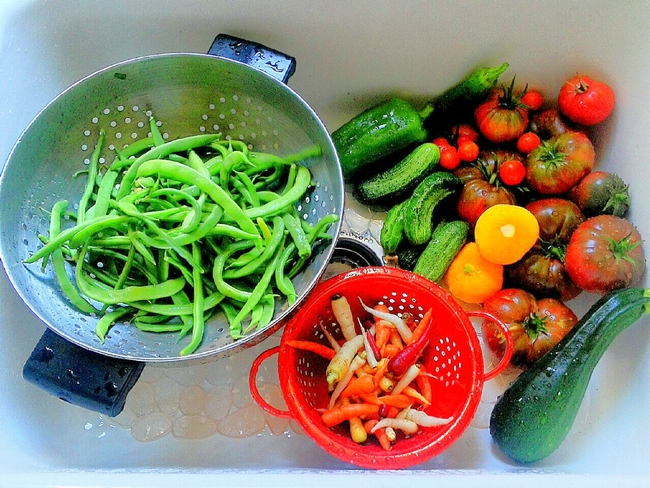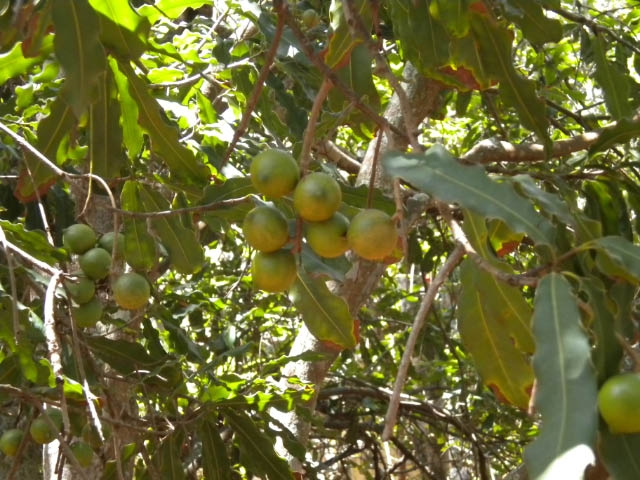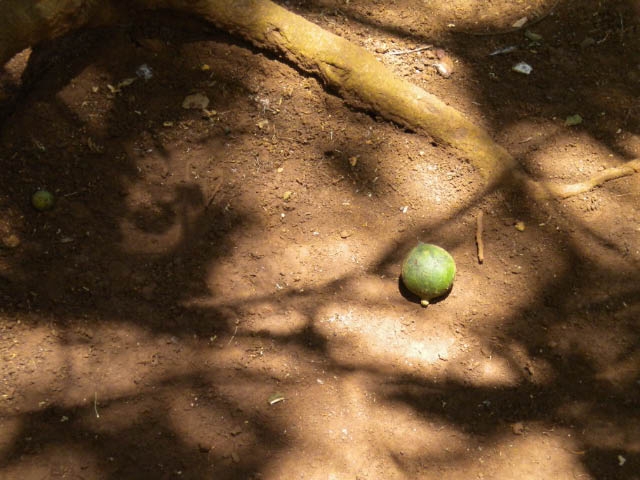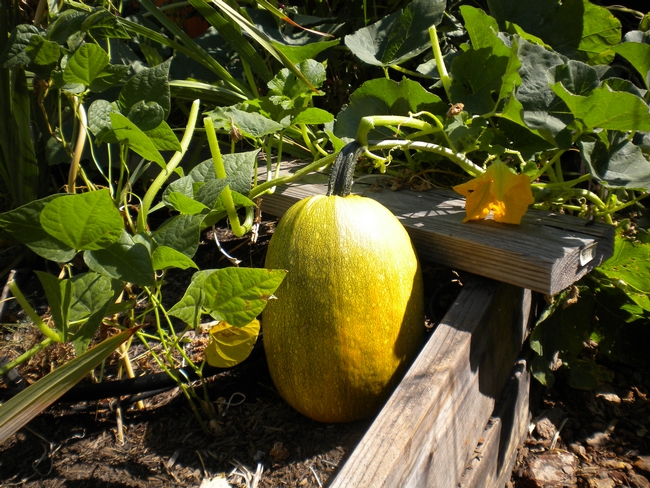Posts Tagged: harvest
Small Garden's Harvest
The first small garden harvest is in. Picture one shows the beginning of the garden, minus the tomato plants. Picture two is the first harvest.
This first harvest may not look like a lot to some gardeners who have a larger garden area to plant in. I have a very small spot where an avocado tree once grew-this is now the small garden.
In this small garden, you will find growing--Kentucky Pole green beans, which are producing more than we can eat now, so we are freezing them for winter. Growing next to the green beans are yellow string beans. In addition to the beans, there are two sweet green peppers, also a Jalapeño, and a peperoncini, 2 sweet Italian long peppers, that I am anxiously waiting for them to turn one yellow the other red, a medium size Italian white eggplant, that has 5 eggplants that are just about ready to be picked.
Tucked in between a Heavenly Bamboo (Nandina domestica) and a (Butterfly bush) Buddleia are 2 tomato plants that are heavy with fruit. In addition to these, I have 3 tomatoes plants in large containers. All the tomatoes were started from seed and are the heirloom variety. Scattered around the yard in containers you can find zucchini, patty pan squash, cucumbers, shallots and a leek, also 3 different kinds of basil, to go with the tomatoes for a caprese salad or tomato sandwiches.
So I have learned if you really want a vegetable garden, you will find the space for it. They need some tending almost every day, especially the ones in the containers, but well worth the effort.

Colorful harvest. (photo by Toni Greer)
The Alfalfa Yield-Quality Tradeoff -Try Some Economics!
‘To cut, or not to cut, that is the question. Whether 'tis nobler to suffer the slings and arrows of outrageously low prices or to harvest when...
Purdy Macadamias
I got the chance to visit a farm recently on Molokai. Amongst other things, they grow macadamia trees, Macadamia integrifolia. They had about fifty trees on their farm that had been there since the 1920s. Farmer Purdy explained that macadamia nuts start off as pale, slender, bottle-brush shaped flower clusters. The flower cluster is pollinated by bees and later forms small green nuts. The nuts grow and when they are ripe, they fall to the ground. The family gathers the nuts daily from the orchard floor. Harvest is essentially year round. The family then husks them, dries them, cracks them and roasts them without any preservatives.
The farmer said that because his is a small multi-crop farm, he has not found the need for any insecticides. The only thing he spreads around the trees is ashes from the burned leaves that he rakes up daily. He stressed that because the crop is picked up from the ground, the orchard must be kept very clean. It was so unique to look up into the tree and see every stage of the nuts' life cycle all growing at the same time. And cool to think of a year round harvest.

Macadamia nuts on the tree. (photos by Karen Metz)

Clusters of macadamia flowers.

One lonely macadamia nut on the ground.
Citrus
One of the things I love about living in Solano County is that we can successfully grow all kinds of citrus trees. I've got quite a few in my backyard - a Meyer lemon tree (Citrus x meyeri), a Robertson orange (Citrus sinensis 'Robertson'), a Bearss lime (Citrus latifolia), and unknown varieties of a blood orange tree (Citrus sinensis) and a kumquat tree (Fortunella spp). They have all been planted over the last 10 years, and slowly, they've grown quite tall (save for the kumquat!). Production has slowly increased, too. In the case of the lemon and orange trees, maybe a bit too good.
Am I the only one who has this little dilemma? The orange tree produces so many oranges, and there are only so many oranges my family is willing to eat. The blood orange tree had four fruits last year. This year, about fifty. I'm a bit nervous to see what happens next year.
The one that amazes me is the Meyer. Our lemon tree has been pruned, hacked, topped, and chopped, yet it still produces what I would certainly call "tons" of lemons. What do I do with all of them? I've made lemon meringue pie (2 lemons), a pitcher of homemade lemonade (10 lemons), hot tea with lemon for a sore throat (1 lemon), bags of lemons for the neighbors (maybe 50 or 60 lemons). Yet still, my tree is heavily drooping with lemons.
Don't misunderstand, I'm glad to have such a bountiful harvest of citrus fruits every winter. There's nothing to brighten up a gray winter January day than to look out and see the orange and yellow fruits hanging sweetly on the trees. Unfortunately, they won't last out there forever, so we need to be creative and find ways to enjoy them without having to partake of them. I recently learned a great new decorating technique - fill a large glass vase with citrus fruits, and enjoy the sweet smell of lemons and oranges in your home as they slowly dry.
So…until I learn of another way to make use of my citrus fruits, my home will be filled with all sizes of glass vessels full of lemons and oranges.
Spaghetti Squash
It seems like every year there is one plant or crop that stands out, sometimes because of its success and sometimes because of its abject failure. This year the spaghetti squash has been the star of the show. I saved the seeds from a squash from a farmers' market and started them in little six packs. I was starting several other kinds of squash as well. This year's garden was slow to get started as we had a prolonged cool spring. By the time things started growing I had forgotten which squash was where. Most of the squash stayed politely where they had been planted, but the spaghetti squash took off running.
Soon it had grown through my tomato cages, escaped the bounds of my raised beds and started up the climbing roses. I would whack it back every now and then to leave room for the other vegetables. After it began flowering and setting fruit, I was amazed at the size of some of them. Some were like small watermelon. Now they have turned from green to orange instead of the expected yellow.
For those of you not familiar with spaghetti squash, it's a winter squash that when halved, seeded, and cooked, has flesh that can be separated into spaghetti like strands with a fork. Squash are famous for their ability to cross pollinate so I'm starting to wonder if there isn't a bit of pumpkin in this squash's background. I guess I won't know until I try and cook them.
When I went on the web to try and look up the proper timing of the spaghetti squash harvest, I had my first exposure to garden forum humor. When others had asked a similar question, the answers had ranged from when the water is boiling to when the meatballs are ready. Apparently the real answer is to let the color change from green to yellow and to wait til the skin thickens, hardens, and cannot be pierced with your fingernail. Then the squash will be able to be stored for months.


